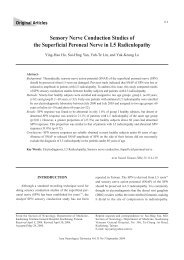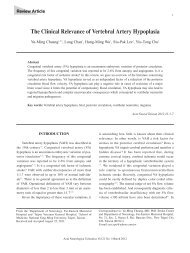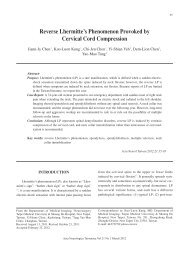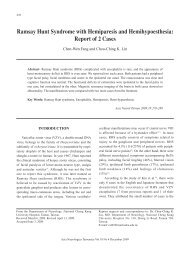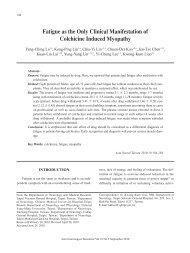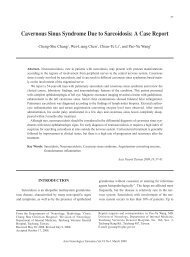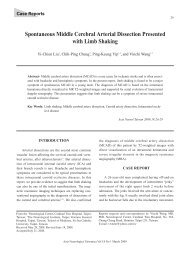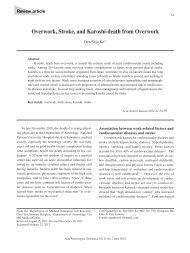Tuberculosis with Meningitis, Myeloradiculitis ... - Vol.22 No.1
Tuberculosis with Meningitis, Myeloradiculitis ... - Vol.22 No.1
Tuberculosis with Meningitis, Myeloradiculitis ... - Vol.22 No.1
You also want an ePaper? Increase the reach of your titles
YUMPU automatically turns print PDFs into web optimized ePapers that Google loves.
192constrictive pial fibrosis (so-called spinal arachnoiditis)(10) . This is characterized on MRI by CSF loculations,obliteration of the spinal subarachnoid space, and thickened,clumped nerve roots in the lumbar region (11) .Contrast-enhanced MRI is helpful in differentiatingactive TB granulomatous disease from chronic fibroticadhesion. Chronic fibrotic tissue shows poor enhancementunder normal MRI (11) . Our patient started to havesymptoms of radiculomyelitis early in the course of hisCNS TB. Level of consciousness, fever and weakness ofthe legs all improved after treatment <strong>with</strong> anti-TB medicationand steroid. However, he still could not walk welldue to bilateral impaired proprioception, hyperreflexiaand clonus. Sphincter dysfunction remained. Follow-upcervical-thoracic spine MRI three months later revealedpersistent leptomeningeal enhancement at the cervicaland thoracic levels. The abnormal enhancement suggestsongoing inflammatory changes. Sequelae may beinduced by adhesive arachnoiditis, which causes irreversibledamage of the posterior column or secondaryaxonal damage of peripheral nerves. Recent medical literaturein the field of CNS TB research identified a phenomenonknown as the “paradoxical reaction” (PR) (12) .This phenomenon refers to observation of clinical orradiological worsening of previous TB lesions or developmentof new lesions after at least one month of TBtreatment in a patient who initially responded to anti-TBtherapy (12) . This PR may explain the abnormal enhancementsignals seen in our patient’s follow-up cervicalspineMRI. Adjunctive corticosteroid therapy is sometimesused in the management of PR (13) . Some authorsbelieve that steroid therapy is probably beneficial tocerebral and spinal edema and spinal block due to itsanti-inflammatory effects (14,15) . However, the benefit forPR very among different studies (13) . Our patient developedPR even though he received adjunctive steroidtherapy from the outset of anti-TB medication treatment.Although the incidence of TB infection is low indeveloped countries, maintaining a high degree of suspicionfor TB infection is vital in order to initiate therapyas soon as possible. From our case, we realized that M.tuberculosis can cause diffuse CNS infection in immunocompetentindividuals. In order to reduce likelihood ofcomplications and sequelae of CNS TB, we should makethe diagnosis as quickly as possible and initiate anti-TBmedication accordingly. Early EVD and shunt surgerymay prevent hydrocephalus and associated irreversibleneurological damage. Further advancement in earlydetection and diagnosis of CNS TB is valuable forphysicians in clinical practice. In conclusion, both methodsfor detection of CNS TB and treatment protocolsshould be constantly re-evaluated to improve treatmentoutcome and reduce likelihood and severity of neurologicalsequelae.REFERENCES1. Bradley WG, Daroff RB, Fenichel GM, Jankovic J Eds.Neurology in Clinical Practice. 5th Ed. : ButterworthHeinemann, 2008:1434-1438.2. Rock RB, Olin M, Baker CA, Molitor TW, Peterson PK.Central nervous system tuberculosis: pathogenesis and clinicalaspects. Clin Microbiol Rev 2008;21:243-261.3. Garcia-Monco JC. Central nervous system tuberculosis.Neurol Clin 1999;17:737-759.4. Chan KH, Cheung RT, Fong CY, Tsang KL, Mak W, HoSL. Clinical relevance of hydrocephalus as a presentingfeature of tuberculous meningitis. QJM 2003;96:643-648.5. Lan SH, Chang WN, Lu CH, Lui CC, Chang HW. Cerebralinfarction in chronic meningitis: a comparison of tuberculousmeningitis and cryptococcal meningitis. QJM 2001;94:247-253.6. El Sahly HM, Teeter LD, Pan X, Musser JM, Graviss EA.Mortality associated <strong>with</strong> central nervous system tuberculosis.J Infect 2007;55:502-509.7. Palur R, Rajshekhar V, Chandy MJ, Joseph T, Abraham J.Shunt surgery for hydrocephalus in tuberculous meningitis:a long-term follow-up study. J Neurosurg 1991;74: 64-69.8. Mathew JM, Rajshekhar V, Chandy MJ. Shunt surgery inpoor grade patients <strong>with</strong> tuberculous meningitis and hydrocephalus:effects of response to external ventriculardrainage and other variables on long term outcome. JNeurol Neurosurg Psychiatry 1998;65:115-118.9. Putruele AM, Legarreta CG, Limongi L, Rossi SE.Tuberculous transverse myelitis: case report and review ofthe literature. Clin Pulm Med 2005;12:46-52.Acta Neurologica Taiwanica Vol 19 No 3 September 2010



